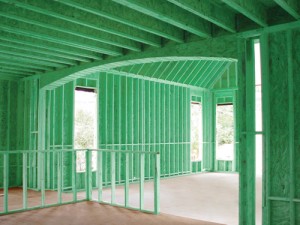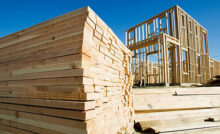Options in Framing
Guest post by Huck DeVenzio, Arch Wood Protection.


Over recent years there have been innovations in framing. These include wood I-beams, Structural Insulated Panels, different truss configurations, finger-jointed studs, and steel studs. These choices provide value-added sales opportunities. Now a new group of framing options – treated woods with differing properties – is entering the market.
Termite and Decay Resistance
The granddaddy of treated framing options is probably borate pressure-treated wood, which has existed for many years although not been widely used. Borates are effective preservatives, recognized in the standards of the American Wood Protection Association and accepted by model building codes for interior applications. They provide resistance to damage from termites and fungal decay, and a study published in the Forest Products Journal suggests that they may also repel non-wood-destroying pests.
There are two levels of protection available with borate-treated wood: one intended for wood used where Formosan subterranean termites are present and one with a lower retention level for defense against less destructive but more common termites.
Borate-treated wood is commonly used for sill plate, but has been used for more than a decade for whole-house framing in Hawaii, where termite problems necessitated treated wood. It has been promoted for total structure protection in the continental U.S., particularly in the Southeast where the need is greatest. To identify borate-treated wood, producers typically add a blue dye to the treating solution. This allows contractors and building inspectors to differentiate borate-treated components from untreated wood.
Fire Retardance
Fire retardant treated (FRT) wood has been used for decades, mandated by building codes attempting to limit the spread of fire and reduce smoke generation in commercial and institutional buildings and in multi-family housing. In addition to reducing fire damages, FRT framing and sheathing can give occupants additional time to escape.
In fire-prone areas, such as crowded urban areas and wildland areas remote from fire protection services, codes are being introduced which incorporate fire resistance in requirements for single-family homes.
Mold Resistance
Homeowners have mold concerns and contractors worry about mold liability. Mold-resistant wood can help minimize the growth of mold and the likelihood of liability claims. To this end, manufacturers have recently introduced anti-mold coatings for framing lumber, trusses, and engineered wood products. The best of these are applied by spray or dip at central locations where the coverage can be controlled and quality monitored, rather than being applied at each jobsite.
As with borate treatment, mold-resistant coatings usually contain a dye, either green or blue, for identification during construction.
The Ultimate Stud?
The ultimate wood stud may be lumber that is pressure-treated with a fire retardant and then coated with an anti-mold solution. In a survey conducted by Good Housekeeping, nearly a quarter of 1200 respondents said they would “definitely” pay 4-7% more for a house with framing that resists fire, produces less smoke, and fights termites and mold. Another 60% answered by saying they “probably” would.
# # #
Author Bio: Huck DeVenzio is manager of marketing communications at Arch Wood Protection, Inc., a leading producer of wood treating chemicals and licensor of some of the best known brands of treated wood, including Wolmanized® lumber. Mr. DeVenzio has been involved with wood preservation since 1973. For more information, visit www.wolmanizedwood.com.
Recent Posts
Framing Stick Nailer vs Coil Nailer
Which is Better a Stick Nailer or Coil Nailer? Framers have many choices in nailers…
How Many Roofing Nails Per Square of Shingles
Estimating How Many Nails for a New Roof When it comes to estimating materials for…
Composite / PVC Decking – Layout Tips & Advice
Composite / PVC Decking Layout Tips and Advice Composite and PVC decking have really changed…
Benefits of an ERV System (Energy Recovery Ventilator)
Benefits of ERV Systems (Energy Recovery Ventilator) If you're building a new home or doing…
Vermiculite Attic Insulation Abatement
Vermiculite Attic Insulation If your home was built before 1990 there is a chance it…
Nuisance Tripping of AFCI (Arc Fault) Circuit Breakers
Arc Fault (AFCI) Circuit Breakers Tripping Often An arc-fault circuit interrupter (AFCI) or arc-fault detection…

View Comments
Very Nice Site Todd,
I found your site well laid out and full of information. I have been a contractor for over 20 and find it refreshing to find a good contractor site in amongst a sea of mediocre sites.
Keep up the great work,
thank you from Kimble K, owner of JKS Custom.